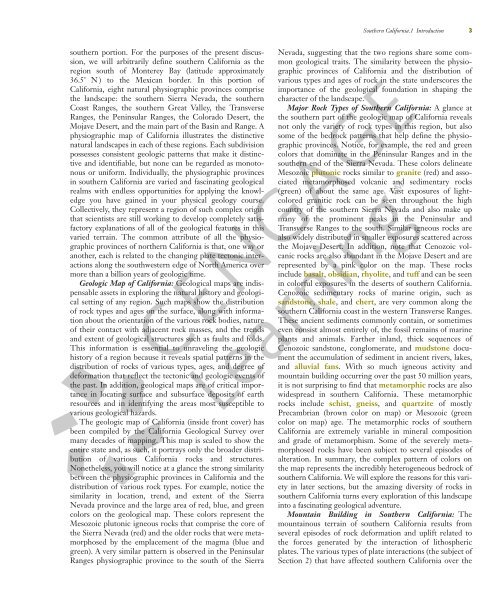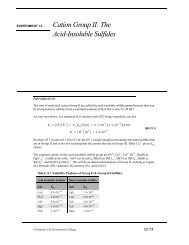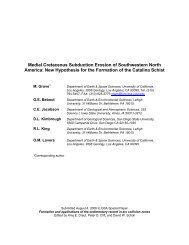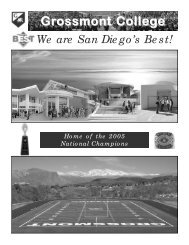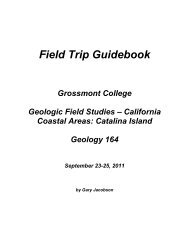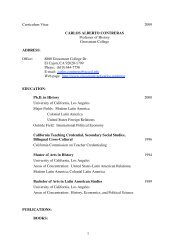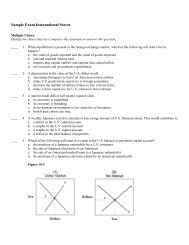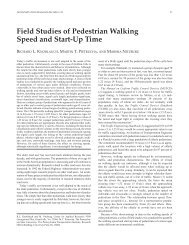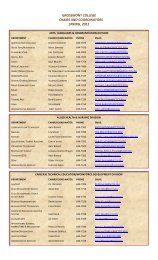Geology of Southern California.pdf - Grossmont College
Geology of Southern California.pdf - Grossmont College
Geology of Southern California.pdf - Grossmont College
Create successful ePaper yourself
Turn your PDF publications into a flip-book with our unique Google optimized e-Paper software.
southern portion. For the purposes <strong>of</strong> the present discussion,<br />
we will arbitrarily define southern <strong>California</strong> as the<br />
region south <strong>of</strong> Monterey Bay (latitude approximately<br />
36.5˚ N ) to the Mexican border. In this portion <strong>of</strong><br />
<strong>California</strong>, eight natural physiographic provinces comprise<br />
the landscape: the southern Sierra Nevada, the southern<br />
Coast Ranges, the southern Great Valley, the Transverse<br />
Ranges, the Peninsular Ranges, the Colorado Desert, the<br />
Mojave Desert, and the main part <strong>of</strong> the Basin and Range. A<br />
physiographic map <strong>of</strong> <strong>California</strong> illustrates the distinctive<br />
natural landscapes in each <strong>of</strong> these regions. Each subdivision<br />
possesses consistent geologic patterns that make it distinctive<br />
and identifiable, but none can be regarded as monotonous<br />
or uniform. Individually, the physiographic provinces<br />
in southern <strong>California</strong> are varied and fascinating geological<br />
realms with endless opportunities for applying the knowledge<br />
you have gained in your physical geology course.<br />
Collectively, they represent a region <strong>of</strong> such complex origin<br />
that scientists are still working to develop completely satisfactory<br />
explanations <strong>of</strong> all <strong>of</strong> the geological features in this<br />
varied terrain. The common attribute <strong>of</strong> all the physiographic<br />
provinces <strong>of</strong> northern <strong>California</strong> is that, one way or<br />
another, each is related to the changing plate tectonic interactions<br />
along the southwestern edge <strong>of</strong> North America over<br />
more than a billion years <strong>of</strong> geologic time.<br />
Geologic Map <strong>of</strong> <strong>California</strong>: Geological maps are indispensable<br />
assets in exploring the natural history and geological<br />
setting <strong>of</strong> any region. Such maps show the distribution<br />
<strong>of</strong> rock types and ages on the surface, along with information<br />
about the orientation <strong>of</strong> the various rock bodies, nature<br />
<strong>of</strong> their contact with adjacent rock masses, and the trends<br />
and extent <strong>of</strong> geological structures such as faults and folds.<br />
This information is essential to unraveling the geologic<br />
history <strong>of</strong> a region because it reveals spatial patterns in the<br />
distribution <strong>of</strong> rocks <strong>of</strong> various types, ages, and degree <strong>of</strong><br />
deformation that reflect the tectonic and geologic events <strong>of</strong><br />
the past. In addition, geological maps are <strong>of</strong> critical importance<br />
in locating surface and subsurface deposits <strong>of</strong> earth<br />
resources and in identifying the areas most susceptible to<br />
various geological hazards.<br />
The geologic map <strong>of</strong> <strong>California</strong> (inside front cover) has<br />
been compiled by the <strong>California</strong> Geological Survey over<br />
many decades <strong>of</strong> mapping. This map is scaled to show the<br />
entire state and, as such, it portrays only the broader distribution<br />
<strong>of</strong> various <strong>California</strong> rocks and structures.<br />
Nonetheless, you will notice at a glance the strong similarity<br />
between the physiographic provinces in <strong>California</strong> and the<br />
distribution <strong>of</strong> various rock types. For example, notice the<br />
similarity in location, trend, and extent <strong>of</strong> the Sierra<br />
Nevada province and the large area <strong>of</strong> red, blue, and green<br />
colors on the geological map. These colors represent the<br />
Mesozoic plutonic igneous rocks that comprise the core <strong>of</strong><br />
the Sierra Nevada (red) and the older rocks that were metamorphosed<br />
by the emplacement <strong>of</strong> the magma (blue and<br />
green). A very similar pattern is observed in the Peninsular<br />
Ranges physiographic province to the south <strong>of</strong> the Sierra<br />
<strong>Southern</strong> <strong>California</strong>.1 Introduction 3<br />
Nevada, suggesting that the two regions share some common<br />
geological traits. The similarity between the physiographic<br />
provinces <strong>of</strong> <strong>California</strong> and the distribution <strong>of</strong><br />
various types and ages <strong>of</strong> rock in the state underscores the<br />
importance <strong>of</strong> the geological foundation in shaping the<br />
character <strong>of</strong> the landscape.<br />
Major Rock Types <strong>of</strong> <strong>Southern</strong> <strong>California</strong>: A glance at<br />
the southern part <strong>of</strong> the geologic map <strong>of</strong> <strong>California</strong> reveals<br />
not only the variety <strong>of</strong> rock types in this region, but also<br />
some <strong>of</strong> the bedrock patterns that help define the physiographic<br />
provinces. Notice, for example, the red and green<br />
colors that dominate in the Peninsular Ranges and in the<br />
southern end <strong>of</strong> the Sierra Nevada. These colors delineate<br />
Mesozoic plutonic rocks similar to granite (red) and associated<br />
metamorphosed volcanic and sedimentary rocks<br />
(green) <strong>of</strong> about the same age. Vast exposures <strong>of</strong> lightcolored<br />
granitic rock can be seen throughout the high<br />
country <strong>of</strong> the southern Sierra Nevada and also make up<br />
many <strong>of</strong> the prominent peaks in the Peninsular and<br />
Transverse Ranges to the south. Similar igneous rocks are<br />
also widely distributed in smaller exposures scattered across<br />
the Mojave Desert. In addition, note that Cenozoic volcanic<br />
rocks are also abundant in the Mojave Desert and are<br />
represented by a pink color on the map. These rocks<br />
include basalt, obsidian, rhyolite, and tuff and can be seen<br />
in colorful exposures in the deserts <strong>of</strong> southern <strong>California</strong>.<br />
Cenozoic sedimentary rocks <strong>of</strong> marine origin, such as<br />
sandstone, shale, and chert, are very common along the<br />
southern <strong>California</strong> coast in the western Transverse Ranges.<br />
These ancient sediments commonly contain, or sometimes<br />
even consist almost entirely <strong>of</strong>, the fossil remains <strong>of</strong> marine<br />
plants and animals. Farther inland, thick sequences <strong>of</strong><br />
Cenozoic sandstone, conglomerate, and mudstone document<br />
the accumulation <strong>of</strong> sediment in ancient rivers, lakes,<br />
and alluvial fans. With so much igneous activity and<br />
mountain building occurring over the past 50 million years,<br />
it is not surprising to find that metamorphic rocks are also<br />
widespread in southern <strong>California</strong>. These metamorphic<br />
rocks include schist, gneiss, and quartzite <strong>of</strong> mostly<br />
Precambrian (brown color on map) or Mesozoic (green<br />
color on map) age. The metamorphic rocks <strong>of</strong> southern<br />
<strong>California</strong> are extremely variable in mineral composition<br />
and grade <strong>of</strong> metamorphism. Some <strong>of</strong> the severely metamorphosed<br />
rocks have been subject to several episodes <strong>of</strong><br />
alteration. In summary, the complex pattern <strong>of</strong> colors on<br />
the map represents the incredibly heterogeneous bedrock <strong>of</strong><br />
southern <strong>California</strong>. We will explore the reasons for this variety<br />
in later sections, but the amazing diversity <strong>of</strong> rocks in<br />
southern <strong>California</strong> turns every exploration <strong>of</strong> this landscape<br />
into a fascinating geological adventure.<br />
Mountain Building in <strong>Southern</strong> <strong>California</strong>: The<br />
mountainous terrain <strong>of</strong> southern <strong>California</strong> results from<br />
several episodes <strong>of</strong> rock deformation and uplift related to<br />
the forces generated by the interaction <strong>of</strong> lithospheric<br />
plates. The various types <strong>of</strong> plate interactions (the subject <strong>of</strong><br />
Section 2) that have affected southern <strong>California</strong> over the


